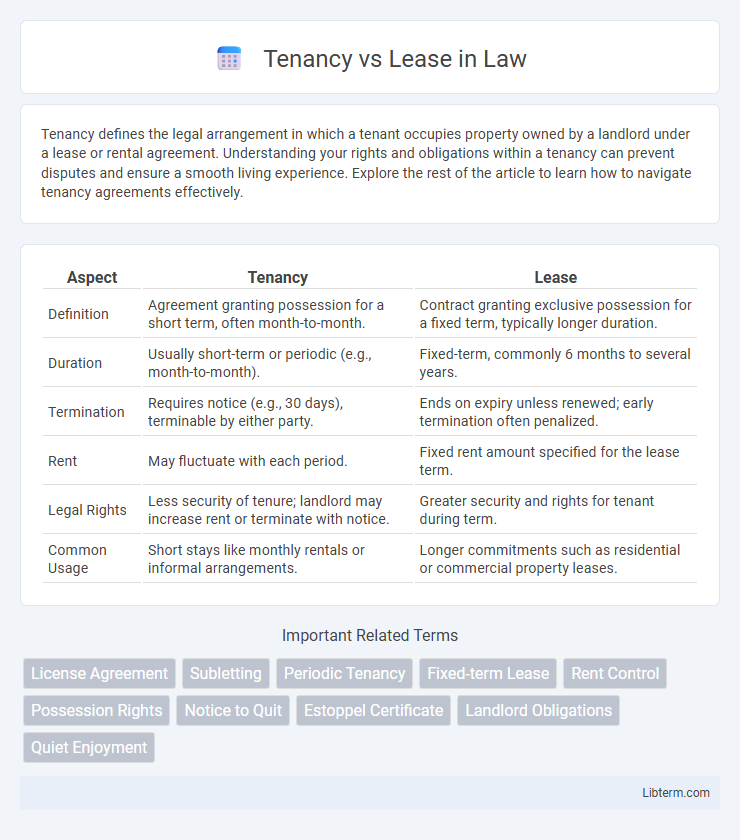Tenancy defines the legal arrangement in which a tenant occupies property owned by a landlord under a lease or rental agreement. Understanding your rights and obligations within a tenancy can prevent disputes and ensure a smooth living experience. Explore the rest of the article to learn how to navigate tenancy agreements effectively.
Table of Comparison
| Aspect | Tenancy | Lease |
|---|---|---|
| Definition | Agreement granting possession for a short term, often month-to-month. | Contract granting exclusive possession for a fixed term, typically longer duration. |
| Duration | Usually short-term or periodic (e.g., month-to-month). | Fixed-term, commonly 6 months to several years. |
| Termination | Requires notice (e.g., 30 days), terminable by either party. | Ends on expiry unless renewed; early termination often penalized. |
| Rent | May fluctuate with each period. | Fixed rent amount specified for the lease term. |
| Legal Rights | Less security of tenure; landlord may increase rent or terminate with notice. | Greater security and rights for tenant during term. |
| Common Usage | Short stays like monthly rentals or informal arrangements. | Longer commitments such as residential or commercial property leases. |
Understanding Tenancy and Lease: Key Definitions
Tenancy refers to the right granted to a tenant to occupy property for a specific period under agreed terms, often implied by payment of rent and possession. Lease is a formal, legally binding contract that outlines detailed rights and obligations between landlord and tenant, including duration, rent, and property use. Understanding the distinction clarifies property rights, with tenancy commonly being short-term or periodic, while leases typically involve fixed terms and comprehensive legal protections.
Types of Tenancy Agreements
Tenancy agreements include periodic, fixed-term, and tenancy at will types, each defining the duration and conditions of occupancy between landlord and tenant. Fixed-term tenancy specifies a set length of time for the lease, typically six months to a year, while periodic tenancy renews automatically on a weekly or monthly basis until terminated. Tenancy at will allows either party to end the arrangement at any time without prior notice, offering maximum flexibility but minimal security for tenants.
Types of Lease Agreements
Types of lease agreements include fixed-term leases, month-to-month leases, and periodic leases, each defining the duration and renewal terms differently. Fixed-term leases establish a specific start and end date, providing tenants with stability and landlords with predictable rental income. Month-to-month leases offer flexibility with automatic renewals until terminated, whereas periodic leases renew at regular intervals without a set end date, accommodating changing tenant needs.
Duration: Short-Term vs Long-Term Occupancy
Tenancy typically refers to short-term occupancy agreements, often on a month-to-month basis, providing flexibility for both landlords and tenants. Lease agreements generally establish long-term occupancy, commonly spanning one year or more, offering stability and fixed rental terms. The duration in tenancy agreements allows easier termination, whereas leases require adherence to contract terms for the specified period.
Rights and Obligations of Tenants vs Lessees
Tenants have the right to exclusive possession of the property for a specified period and must pay rent as agreed, while lessees hold similar possession rights under a lease contract but often with more detailed obligations such as maintenance and compliance with lease terms. Tenants are typically protected by residential tenancy laws ensuring habitability, whereas lessees may face stricter duties concerning property use and upkeep depending on the lease agreement. Both tenants and lessees must respect property rules, but lessees often assume greater responsibility for damages and property management during the lease term.
Renewal and Termination: Flexibility Differences
Tenancy agreements generally offer greater flexibility in renewal and termination, allowing periodic rent adjustments and easier notice requirements. Lease contracts typically have fixed terms with predetermined end dates, requiring formal renewal processes and stricter termination conditions. This distinction impacts tenants' and landlords' ability to adapt to changing circumstances or terminate arrangements without penalties.
Legal Protections for Tenants and Lessees
Legal protections for tenants under tenancy agreements often include statutory rights to notice periods, rent regulation, and eviction safeguards designed to prevent unlawful displacement. Lease agreements typically grant lessees stronger contractual security with fixed terms and specific property use rights but may offer less flexibility in terminating the agreement compared to tenancy. Both tenancy and lease agreements are governed by local landlord-tenant laws, with leases providing clearer legal recourse for breaches, while tenancies commonly afford tenants more protections against abrupt changes imposed by landlords.
Financial Implications: Deposits, Rent, and Fees
Tenancy agreements often require a security deposit typically equivalent to one month's rent, while leases may demand higher deposits based on the lease duration and credit checks. Rent in tenancy arrangements is usually flexible with periodic reviews, whereas lease agreements guarantee fixed rent for the entire term, providing predictable financial planning. Fees such as maintenance, utilities, and late payment charges vary, with leases often outlining detailed responsibilities to prevent unexpected expenses.
Dispute Resolution in Tenancy and Lease Contracts
Dispute resolution in tenancy and lease contracts typically involves mechanisms such as mediation, arbitration, and litigation to address conflicts over rent, property maintenance, or contract terms. Tenancy agreements often have statutory protections and standardized dispute resolution processes governed by residential tenancy laws, which may include specialized tribunals or housing courts. Lease contracts, especially commercial leases, usually incorporate detailed dispute resolution clauses that mandate arbitration or litigation, reflecting the more complex and negotiated nature of these agreements.
Choosing the Right Option: Factors to Consider
Choosing between tenancy and lease agreements requires evaluating factors such as duration flexibility, legal obligations, and financial commitments. Tenancy often suits short-term or flexible living arrangements, while leases provide stability and fixed terms, often preferred for long-term accommodations or commercial properties. Consider the nature of the property, intended length of stay, and specific rights and responsibilities outlined in each agreement to select the most suitable option.
Tenancy Infographic

 libterm.com
libterm.com